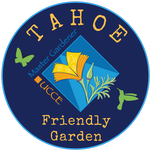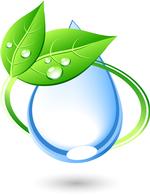Tahoe Friendly Garden: Water Conservation

Planning for water efficiency is an extremely important component of landscape planning in the arid west. A well planned and water-efficient landscape not only helps the environment, but it also helps you avoid unnecessary headaches and heartaches over foiled plantings and disappointing designs.

- Showy Penstemon spp., Penstemon
- Blanketflower, Gaillardia pulchella
- Wooly Speedwell, Veronica incana
- Stonecrop, Sedum spp.
- Ninebark, Physocarpus
Tips for Water-Conservation:
- Plan and design comprehensively
- Use water-efficient plants
- Water efficiently with properly designed irrigation
- Use mulch to reduce evaporation
- Create practical turf areas
- Care for your soil
- Practice appropriate maintenance
What is a water-wise garden?
Many of us have heard the terms “water-wise,” “water-efficient,” “native/ sustainable landscaping,” or “xeriscaping” or some variation of these terms. Essentially, the concept refers to the practice of choosing plants that are adapted/native to our Tahoe environment while watering in a manner that maximizes the benefit to the plant/grass water uptake. Grass and plants can only “uptake” or absorb so much water at any given time. Efficient irrigation ensures that plants receive the water they need to thrive. A well planned and water-efficient landscape not only helps the environment, but it also helps you avoid unnecessary headaches and heartaches over foiled plantings and disappointing designs.
A typical household uses approximately 260 gallons of water per day. In the summer months, water use can increase by 250%, the majority of which goes for outdoor watering. An attractive, sustainable landscape that minimizes water use and uses sound horticultural principles is one possible solution to this problem.
Developing a landscape plan is the first and most important step in creating a water-efficient landscape. Your plan should consider your regional climate as well as the micro-climates within your yard: some areas will be sunny and hot while others are shaded, higher soils may drain faster than low spots. Observe how many hours of sunlight each area of your plan receives and make notes. Consider existing vegetation and work to preserve trees and shrubs. Think about how you use your yard. Do you entertain guests, need a place for children to play, want to block an ugly view? Once you have determined your needs, mapped out micro-climate zones and considered the placement of structures and existing vegetation you are ready to think about your new plants. Group your plants by water needs. If you can’t bear to part with a water-loving plant consider creating a small oasis of plants with similar needs.
Once you are ready to move from plan to action these resources can be of assistance:
- USDA-NRCS:
- Water Efficient Landscaping in the Lake Tahoe Basin- http://tahoercd.org/wp-content/uploads/2013/03/Water-Efficient-Landscaping.pdf
- Turf Watering Management- http://tahoercd.org/wp-content/uploads/2013/03/Turf-Watering-Management.pdf
- USEPA:
- Water Smart Landscapes- https://www3.epa.gov/watersense/docs/water-efficient_landscaping_508.pdf
- Tahoe Resource Conservation District:
- Demystifying Irrigation- http://tahoercd.org/wp-content/uploads/2013/03/De-Mistifying-Irrigation.pdf
- Irrigation Schedule- http://tahoercd.org/wp-content/uploads/2013/03/Irrigation-Schedule.pdf
- Improve Irrigation Efficiency- http://tahoercd.org/wp-content/uploads/2013/03/Improve-Irrigation-Efficiency.pdf
- How to Convert Lawn Sprinklers to Micro-Irrigation- http://tahoercd.org/wp-content/uploads/2013/03/How-To-Convert-Lawn-Sprinklers-to-Micro-Irrigation.pdf
- How to: Remove Turf- http://tahoercd.org/wp-content/uploads/2013/03/How-to-Remove-Turf.pdf
- How-to: Lawn Conversion by Sheet Mulching- http://tahoercd.org/wp-content/uploads/2013/03/Lawn-Conversion-by-Sheet-Mulching.pdf
- Local Regulations:
- California:
- South Tahoe Public Utility District- https://stpud.us/waterconsv/water-restrictions-2/
- Truckee Donner Public Utility District- http://www.tdpud.org/departments/conservation
- Tahoe City Public Utility District- http://www.tahoecitypud.com/water_efficiency_rebates.shtml
- Tahoe Keys POA- https://www.tkpoa.com/association/departments/water-department
- Nevada: (13 GID)
- Kingsbury General Improvement District
- Roundhill General Improvement District
- Glenbrook HOA
- Washoe General Improvement District
